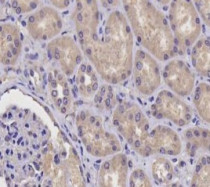ARG44891
anti-PIKFYVE antibody
anti-PIKFYVE antibody for IHC-Formalin-fixed paraffin-embedded sections and Human
Overview
| Product Description | Mouse Monoclonal antibody recognizes PIKFYVE |
|---|---|
| Tested Reactivity | Hu |
| Tested Application | IHC-P |
| Host | Mouse |
| Clonality | Monoclonal |
| Isotype | IgG2b |
| Target Name | PIKFYVE |
| Antigen Species | Human |
| Epitope | AEEGDDNLAN SASPSKRTSV SSFQSTVDSD SAASISLNVE LDNVNFHIKK PSKYPHVPPH PADQKEYLIS DTGGQQLSIS DAFIKESLFN RRVEEKSKEL PFTPLGWHHN NLELLREENG |
| Conjugation | Un-conjugated |
| Alternate Names | PIKFYVE; Phosphoinositide Kinase, FYVE-Type Zinc Finger Containing; KIAA0981; ZFYVE29; PIP5K3; PIP5K; FAB1; Phosphatidylinositol-3-Phosphate/Phosphatidylinositol 5-Kinase, Type III; Phosphatidylinositol 3-Phosphate 5-Kinase Type III; Phosphoinositide Kinase, FYVE Finger Containing ; 1-Phosphatidylinositol 3-Phosphate 5-Kinase; Zinc Finger, FYVE Domain Containing 29; Serine-Protein Kinase PIKFYVE; Type III PIP Kinase; PIPkin-III; MGC40423; P235; FYVE Finger-Containing Phosphoinositide Kinase; Phosphatidylinositol 3-Phosphate 5-Kinase; Epididymis Luminal Protein 37; EC 2.7.1.150; EC 2.7.11.1; PIKfyve; HEL37; CFD |
Application Instructions
| Application Suggestion |
|
||||
|---|---|---|---|---|---|
| Application Note | * The dilutions indicate recommended starting dilutions and the optimal dilutions or concentrations should be determined by the scientist. |
Properties
| Form | Liquid |
|---|---|
| Purification | Protein A purification |
| Buffer | PBS with 0.09% sodium azide |
| Preservative | 0.09% sodium azide |
| Storage Instruction | For continuous use, store undiluted antibody at 2-8°C for up to a week. For long-term storage, aliquot and store at -20°C or below. Storage in frost free freezers is not recommended. Avoid repeated freeze/thaw cycles. Suggest spin the vial prior to opening. The antibody solution should be gently mixed before use. |
| Note | For laboratory research only, not for drug, diagnostic or other use. |
Bioinformation
| Database Links |
Swiss-port # Q9Y2I7 Human 1-phosphatidylinositol 3-phosphate 5-kinase |
|---|---|
| Gene Symbol | PIKFYVE |
| Gene Full Name | Phosphoinositide Kinase, FYVE-Type Zinc Finger Containing |
| Background | Phosphorylated derivatives of phosphatidylinositol (PtdIns) regulate cytoskeletal functions, membrane trafficking, and receptor signaling by recruiting protein complexes to cell- and endosomal-membranes. Humans have multiple PtdIns proteins that differ by the degree and position of phosphorylation of the inositol ring. This gene encodes an enzyme (PIKfyve; also known as phosphatidylinositol-3-phosphate 5-kinase type III or PIPKIII) that phosphorylates the D-5 position in PtdIns and phosphatidylinositol-3-phosphate (PtdIns3P) to make PtdIns5P and PtdIns(3,5)biphosphate. The D-5 position also can be phosphorylated by type I PtdIns4P-5-kinases (PIP5Ks) that are encoded by distinct genes and preferentially phosphorylate D-4 phosphorylated PtdIns. In contrast, PIKfyve preferentially phosphorylates D-3 phosphorylated PtdIns. In addition to being a lipid kinase, PIKfyve also has protein kinase activity. PIKfyve regulates endomembrane homeostasis and plays a role in the biogenesis of endosome carrier vesicles from early endosomes. The protein plays a key role in cell entry of ebola virus and SARS-CoV-2 by endocytosis Mutations in this gene cause corneal fleck dystrophy (CFD); an autosomal dominant disorder characterized by numerous small white flecks present in all layers of the corneal stroma. Histologically, these flecks appear to be keratocytes distended with lipid and mucopolysaccharide filled intracytoplasmic vacuoles. [provided by RefSeq, Jul 2021] |
| Function | (Microbial infection) Required for cell entry of coronaviruses SARS-CoV and SARS-CoV-2, as well as human coronavirus EMC (HCoV-EMC) by endocytosis. [Uniprot] |
| Cellular Localization | Cytoplasmic vesicle, Endosome, Membrane. [Uniprot] |
| PTM | Acetylation, Phosphoprotein. [Uniprot] |
Images (1) Click the Picture to Zoom In






